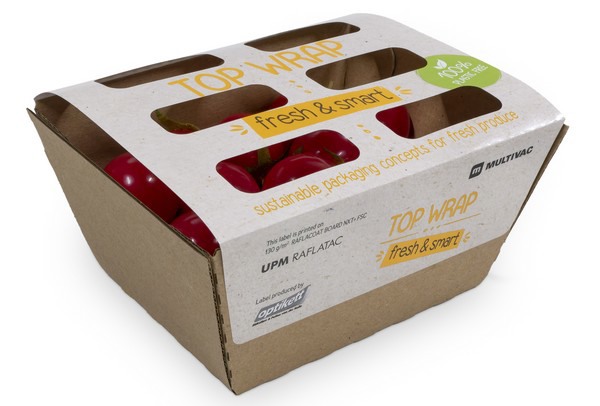Multivac offers two resource-saving solutions for the closing of fresh produce trays with labels with their Top Wrap and Top Close labellers. At interpack 2023, Multivac will be presenting the new L 310 Top Wrap/Top Close conveyor belt labeler, which enables both labeling operations to be performed on one machine.

Attractive, environmentally-friendly packaging of fresh products
When it comes to the marketing of fruit and vegetables, recyclable packs are very much on trend. In addition to full wrap labeling, Multivac now offers two more high-quality and sustainable labeling solutions for fresh produce trays. Whereas Top Wrap involves applying a label to the top and both sides of the tray, Top Close closes the tray just with a label from above. Both concepts are ideal for fresh products, which do not have to be packed under a modified atmosphere or airtight in a vacuum. This means that a label can be used to simply close the tray and label it at the same time in one resource-saving operation - and it also meets the rising demand in this sector for sustainability.
Both labeling solutions provide a strong purchasing incentive thanks to their attractive label and recyclable pack. The self-adhesive labels on a backing material not only offer a large area for customer information and marketing purposes, but they also open up a wide range of possibilities for product presentation in terms of material thickness and label shape. Perforations serve as opening aids and make the handling of the packs easy for the consumer. The label can also be printed on the labeler itself with a lot number or best-before date, for example, and this means that an additional label for this is not required. Producers and packers benefit from using unprinted cardboard trays, which offer flexible and efficient ordering and storage processes.
In the case of Top Wrap, the label ensures that the content can not fall out of the tray or be removed by the customer. In contrast to so-called full wrap labeling, the label is only applied to the top and two sides and not around the complete pack. This saves material and still fulfills its purpose - and it is significantly more efficient with its output of 180 packs per minute. “Thanks to a combination of cardboard trays and standard self-adhesive labels made of paper or renewable materials, this produces a plastic-free pack that can be easily and perfectly recycled,” explains Michael Reffke, Product Manager for Labelling Technology at Multivac Marking and Inspection.
It is also possible with Top Wrap to use film labels made of polypropylene. It offers the benefit that the product is visible thanks to a transparent viewing window on the top of the tray. “The proportion of plastic in such a pack is under 10 % depending on the label material used. The label can also be easily removed, making it simple for the consumer to separate the materials into the different recycling channels,” explains Reffke.
In the case of Top Close, plastic or cardboard trays with a wide flange, or even round trays, can be closed simply and securely on the top and labeled at the same time. The label only adheres to the flanges of the tray. Thanks to an adhesive-free zone in the middle of the label, the product does not come into contact with the adhesive. Transparent labels also allow the product to be viewed, while ventilation holes ensure that there is air circulation.
With an output of up to 250 products per minute, a labeler with Top Close has a particularly high output. The trays are automatically labeled on the run, and they are either fed in manually or transferred automatically from an upstream module. When compared with time-consuming, manual packaging solutions, this provides tangible cost savings and a very efficient process.
For more information:
Andrea Vollenkemper
Multivac
Tel.: +49 (0) 5224 931-208
Email: andrea.vollenkemper@multivac.de
www.multivac.com
